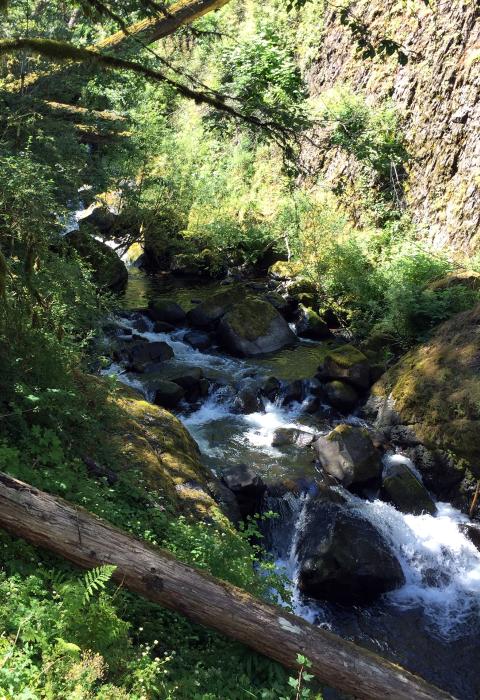South Fork Clackamas River
Oregon
The South Fork of the Clackamas River is a tributary of the Clackamas River on the western slope of the Cascade Range in northwest Oregon. The 4.2-mile segment flows from its confluence with the East Fork of the South Fork of the Clackamas River and merges with Memaloose Creek to join the mainstem Clackamas River less than an hour's drive from Portland. As it flows through a narrow canyon with large rock outcrops and cliffs, a 100-foot waterfall in the lower part of the segment and old-growth trees along the river add to the visual diversity. Seasonally, deer and elk are in the area, and spotted owls and bald eagles also call the watershed home. Most of the watershed, filled with Pacific silver fir, Douglas fir and western hemlock, is under the care of the U.S. Forest Service.
Designated Reach
March 30, 2009. From its confluence with the East Fork of the South Fork Clackamas River to its confluence with the Clackamas River.
Outstandingly Remarkable Values
Culture
There is evidence of significant human use prior to European exploration and settlement, as well as a wide variety of evidence of historic use. The prehistoric sites consist of mainly lithic scatters and modified trees (peeled cedars, springboard notches, etc.). Native American uses within the river corridor have not been fully documented. It is likely that these uses are limited to informal berry gathering near the headwaters and fishing along the entire length of the river. The historic sites include railroad/road buildings, hydro-electric facilities, and old Forest Service facilities. The Clackamas River has played an important role in local and regional development.
Ecology
The river corridor encompasses a diversity of vegetation types and habitat. The river corridor is composed of a mosaic of riparian, wetland, and upslope non-riparian plant communities. Botanical and ecological values along the river include high-elevation mixed conifer in the headwaters. Lower elevations have old-growth Douglas-fir communities that are increasingly less common in the region. The Big Bottom area represents an example of forest vegetation once common along Cascade rivers.
Fish
There are small resident rainbow and cutthroat trout populations above the falls. Below the falls, spring chinook, winter and summer steelhead, fall run coho, and a late-winter run of coho are found. The Clackamas River contains the last significant run of wild, late-winter coho; a native stock of salmon, increasingly rare in the Columbia Basin (one of two remaining historic runs of spring chinook in the Willamette Basin); and an important population of winter steelhead run.
Recreation
This is one of the most remote large streams in the state. Recreational uses include hiking, mountain biking, backpacking, whitewater boating, and access to catch-and-release fishing. The proximity to Portland results in high recreation demand and a high potential for recreation-related interpretive opportunities.
Wildlife
Riparian and upland habitats within the Clackamas River corridor support diverse communities of birds, mammals, amphibians, and invertebrates. Riparian area stands of old-growth Douglas-fir, western hemlock, and western redcedar provide valuable and increasingly rare habitat for many species, including the northern spotted owl. Other key wildlife species that inhabit the corridor include Rocky Mountain elk, pileated woodpecker, pine marten, osprey, bald eagle, river otter, beaver, and riparian-associated amphibians. Outstanding potential exists for wildlife-related interpretive opportunities.

